Colorado
| |
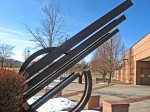 |
Arvada |
Colorado |
USA |
Horizontal Dial |
Dial 22 |
| A large horizontal dial of brick and stone with a formed structural steel gnomon in the form of a modern sculpture. Roman numeral hour marks doe DST are on raised brick pillars. |
| |
| |
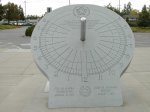 |
Aurora |
Colorado |
USA |
Equatorial Dial |
Dial 81 |
| A large Erickson Monument equatorial polar dial 6 feet in diameter made of light granite with a 3 inch steel rod as gnomon. The dial was dedicated as part of the bicentennial celebrations in July 1976. Hour lines from 4am to 8pm. Time is graduated by half-hour, quarter hours and 5 minute marks. Designed to be read from the upper surface in Spring/Summer, from the under side in Fall/Winter. A plaque provides the Equation of Time to convert solar time to watch time. Dial has both the bicentennial emblem and the city seal of the city of Aurora. |
| |
| |
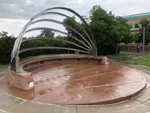 |
Aurora |
Colorado |
USA |
Gnomonic or Projection Dial |
Dial 963 |
| The Sun Shell is a band shell made of a series of six stainless steel arcs creating the illusion of longitude lines on a globe tilted so the poles are on the east-west horizon. A nodus is placed on one of the arcs that casts a point of light onto the floor of the band shell plaza. The floor is marked with Arabic numerals and stainless steel hour lines from 10 am to 3 pm. |
| |
| |
 |
Boulder |
Colorado |
USA |
Horizontal Dial |
Dial 137 |
| A horizontal dial using a 60 cm brass plate gnomon with a slit that projects a shaft of light onto the dial face inscribed with un-numbered hour lines. Dial sits atop a cubical marble base with a plaque bearing the inscription. |
| |
| |
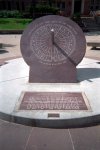 |
Boulder |
Colorado |
USA |
Equatorial Dial |
Dial 172 |
| A large polar equatorial dial by Erickson Monuments, known as the "Tippit Sundial" given by John Tippit in memory of his son. The dial is of dark red granite, 6 feet in diameter and 6.375 inches thick. The gnomon shaft is steel, extending from the ground through the dial plate and outward another two feet. 24 hours are inscribed on each side of the dial (summer and winter) as radiating lines with Arabic numbers at the end. Time is graduated by half-hour and 5 minute marks. Designed to be read from the upper surface in Spring/Summer, from the under side in Fall/Winter. The hours on the under side of the dial were originally engraved backwards. Two plaques provide the Equation of Time to convert solar time to watch time. The dial rests on a cement work 7 feet high. |
| |
| |
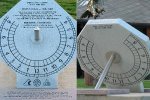 |
Brighton |
Colorado |
USA |
Equatorial Dial |
Dial 514 |
| This equatorial dial is one of the more distinctive Erickson Monument dials. It is octagonal about 4 feet across, made of white granite. It has a supporting stainless steel rod as gnomon. Hours from 4am to 8pm with 15 minute divisions. The hours are not rotated for longitude, placing the 12pm hour directly at nadir. Below the sundial is a plaque containing a graph of the equation of time. |
| |
| |
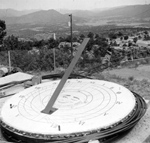 |
Cañon City |
Colorado |
USA |
Horizontal Dial |
Dial 1028 |
| This sundial was constructed in 1969 on the top of a 10-foot round column on a 75-ton block of reinforced concrete by Heron Construction Co. to anchor an aerial tram cables spanning 2200 feet across the Royal Gorge. The column was tilted away from the cables and the station on the opposite side of the gorge, so the dial face is inclined about 4 degrees, sloping in a direction about 9 degrees west of due south.The original dial was designed by William L. Peterson of Time & Space LTD, Denver, CO (said to be a sundial expert by a newspaper article, but no further r information), and painted by a local sign painter, Ray Hawes. |
| |
| |
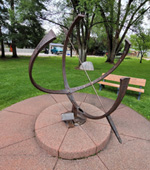 |
Carbondale |
Colorado |
USA |
Equatorial Dial |
Dial 1101 |
| This equatorial is of hammered wrought iron about 2m (6 ft) in diameter with fluted ends on both the equatorial and meridian arcs. Time is shown from 4am to 8pm with small brass hour marks engraved with Roman numerals. Time is offset for the longitude correction. Brass cardinal directions are set into the iron based |
| |
| |
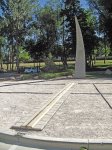 |
Colorado Springs |
Colorado |
USA |
Obelisk or Vertical Gnomon |
Dial 696 |
| A point-in-space or nodus dial with a 65 foot diameter dial face with seasonal markers extending nearly 150 foot wide due to uneven terrain. Time and date are indicated by the shadow of the tip of the 15 foot high curved gnomon. The dial is made of concrete, steel angle, cast iron and Breeze Stone, a compacted crushed stone. Roman hour numerals are cast iron, cast by students at The Colorado Springs School. The dial was designed and built by students, alumni and faculty of the school over a five year period. Provision is made for 60 stone date markers, set to indicate dates of significance to the school calendar. |
| |
| |
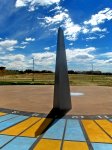 |
Colorado Springs |
Colorado |
USA |
Horizontal Dial |
Dial 604 |
| A monumental 120 foot diameter horizontal dial of painted concrete with a vertical 12 foot high concrete gnomon. Standard time and DST hour numerals are shown as are solstice and equinox lines. Dial face includes two 6 foot diameter inlaid mosaic maps of the Western and Eastern Hemispheres. The gnomon is a truncated three-sided equilateral pyramid that inclines to the north so that the northern corner is vertical. Two bronze plaques give instructions for reading and equation of time correction. Seen from above, the overall design incorporates a Yin Yang symbol appropriate for this elementary school specializing in teaching Chinese language and culture. |
| |
| |
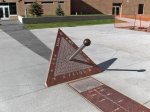 |
Colorado Springs |
Colorado |
USA |
Equatorial Dial |
Dial 570 |
| A 4 inch thick rose granite equatorial dial with a triangular dial face 60 inches on a side. A 70 inch long gnomon rod holds a 6 inch diameter spherical bronze nodus showing Earth as seen from space placed so that the Earth's axis is on the gnomon axis. The dial face shows solar noon and the dateline shows the date at solar noon and the equation of time. The granite plates are set 4 inches into concrete. |
| |
| |
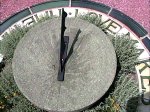 |
Colorado Springs |
Colorado |
USA |
Horizontal Dial |
Dial 500 |
| An old horizontal dial approx 60 cm diameter. From 1914-1967 was located at Marksheffel Garage, relocated to Monument Valley Park in 1967. The builder may have been van Briggle Pottery, but its history is more complex: The angles of the hour lines are consistent with a latitude of 43.9° (roughly) but the present location is 38.9°. A gnomon (probably not original) was cut for 34° lat, but has now been corrected. Likewise, the whole dial had to be rotated to true north, being off by some 47°. Hour lines have eroded, and those before 6am and after 6pm radiate from the wrong side of the gnomon. The city has spent a considerable amount of money cleaning up the area, removing the shrubs that blocked sunlight and building a nice brick wall with flowerbeds, so the area looks better, but the dial is worse than ever, with vandals bending the gnomon. |
| |
| |
 |
Colorado Springs |
Colorado |
USA |
Vertical Dial |
Dial 499 |
| A vertical dial approximately one meter square, built into the wall of the 1907 Van Briggle Pottery building. This Memorial Pottery building was erected after Artus Van Briggle's death. The Van Briggle Pottery Company is now using the Midland Railway roundhouse at Hwy 24 and 21st. In addition to hour lines with Roman numerals, surrounding tiles have pictures of the zodiac. In 1994 Colorado College repaired the gnomon and added a metal equation of time plate. |
| |
| |
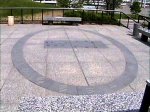 |
Colorado Springs |
Colorado |
USA |
Analemmatic Dial |
Dial 222 |
| Analemmatic dial in granite and bronze. 9ft x 12ft. Mottled granite block surface with number border of smooth granite blocks. Hour numbers are engraved in granite. Zodiac marker is brass, embedded in the granite face. As with most analemmatics, the dial is not corrected for longitude. Fortunately, the location is very close to the center of the time zone at 105 deg W. User stands on a central analemma at correct date and acts as the gnomon to cast a shadow that points to local solar time. The aspect ratio is not correct for the latitude and the positions of the solstice markers are slightly off. |
| |
| |
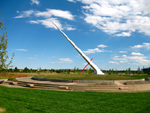 |
Denver |
Colorado |
USA |
Horizontal Dial |
Dial 965 |
| This monumental dial has a 58 foot tall gnomon made of aluminum cladding on a steel frame sitting on a concrete base. The surrounding elliptical walkway has red sandstone lines marking the time from 6 am to 6 pm. Time may be slightly off as the time lines do not account for the change in height between the walkway and the dial base. The markers south of the 6 o'clock lines are added only to provide artistic balance and do not mark time. |
| |
| |
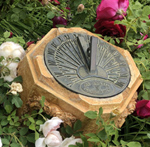 |
Denver |
Colorado |
USA |
Horizontal Dial |
Dial 964 |
| A 12 inch bronze horizontal dial marking quarter hours with Roman numerals.from 5 AM to 7 PM. The gnomon is about 1 1/2 inches wide and the hour lines are appropriately split at the noon marker. The dial sits on 3-foot stone plinth. |
| |
| |
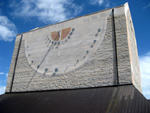 |
Denver |
Colorado |
USA |
Vertical Dial |
Dial 967 |
| This monumental size vertical dial consumes much of the south side of the Newman Center for the Performing Arts. The dial face is limestone and sandstone with disks standing out from the wall to mark the hours from 7am until 5pm. Two row of brass disks show the time: one circular set close to the gnomon for winter and another set at the circumference for summer. The size of the disks vary, growing in size from 7am to noon, then repeating the growing size from 1pm until 5pm. Roman numerals at 7, 12, and 5 show the hours. |
| |
| |
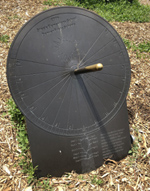 |
Denver |
Colorado |
USA |
Equatorial Dial |
Dial 972 |
| Bronze equatorial dial marking hours with Arabic numerals from 4:00 am to 8:30 pm for summer and from 5:00 am to 7 pm in winter. Additional marks indicate time in 15 minute and 5 minute intervals. Noon gap to choose gnomon shadow side. Hour lines marked from leading edge of shadow. The dial may be rotated by a hand wheel at bottom of the dial to adjust for both the equation of time and daylight savings time. |
| |
| |
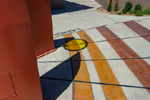 |
Denver |
Colorado |
USA |
Gnomonic or Projection Dial |
Dial 1010 |
| This gnomonic sundial uses an oculus high above ground level to project sunlight through a large overhead disc made of yellow plexiglass with a hole in the center to provide a brighter spot of sunlight surrounded by a yellow ellipse to show date and time. The light projects onto a large gnomonic calendar in colored concrete designating the months and hour lines from 10am-2pm standard time. Summer hours are designated from 11am-3pm. |
| |
| |
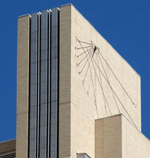 |
Denver |
Colorado |
USA |
Vertical Dial |
Dial 962 |
| A massive vertical dial, declining 48.08 degrees south of east, occupying the upper portion of the Arraj US Courthouse. Hours are marked from 5 am to 3 pm with Arabic numerals. The hour lines are crossed by declination lines for summer solstice, equinox, and winter solstice. |
| |
| |
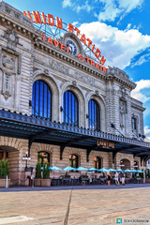 |
Denver |
Colorado |
USA |
Noon Mark or Meridian Dial |
Dial 958 |
| Description, a 1-inch stainless steel line set in the granite pavement marks the location of the 105th meridian in front of Union Station. The meridian line marks the center of the time zone called Mountain Time, and is 7 time zones "earlier" the Greenwich. MT = UTC - 7. Throughout the Denver metro area, Kalamath Street is the road that most closely corresponds to the 105th meridian. The current 105th meridian would have been known as the 30th meridian of the United States in the 18th and 19th century. |
| |
| |
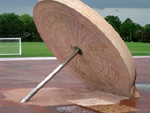 |
Denver |
Colorado |
USA |
Equatorial Dial |
Dial 24 |
| Large Erickson equatorial monument dial. It consists of a disc of pink granite about 6 feet in diameter and 6 inches thick, tilted on edge to align with the earth's equator. The gnomon is a stainless steel rod approximately 3 inches in diameter, piercing the disc at 90 degrees. It supports the disc from below, and protrudes about 2-3 feet above the disc; far enough that it casts a shadow on the face of the disc all summer. Winter shadows fall on the back side of the dial, also engraved with hour lines. |
| |
| |
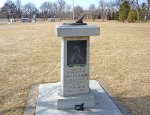 |
Denver |
Colorado |
USA |
Horizontal Dial |
Dial 672 |
| A cast bronze round horizontal dial with 4 AM to 7 PM hour lines and Roman numerals. The gnomon has an unusual curved root, making it appear to be misplaced to the south on the dial face when it appears to actually be correctly placed. Dial sits on a marble pedestal |
| |
| |
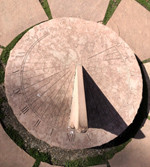 |
Denver |
Colorado |
USA |
Horizontal Dial |
Dial 371 |
| The horizontal stone dial face is about 45 inches across, and is raised eight inches above ground level. It is inscribed with hours from IV to VIII. The dial was created about 1974 in memory of Persis McMurtrie Owen, who designed the west herb garden of the Botanic Gardens in 1964. See NASS Compendium Vol. 6 No. 2, June 1998 |
| |
| |
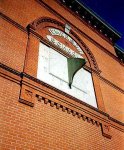 |
Denver |
Colorado |
USA |
Vertical Dial |
Dial 368 |
| On the southwest side of the Emerson School Building (now an office building and historic landmark) is a large white stone vertical dial with a stone gnomon. The large stone dial is part of the original brick building erected in 1884. Local history holds that the original architect was somewhat staid and stuffy and only agreed to include the sundial "because of its educational value." The dial was restored when the building was refurbished. See "Sightings" in NASS Compendium Vol. 6 No. 4, Dec 1999. |
| |
| |
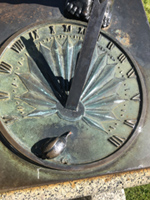 |
Denver |
Colorado |
USA |
Horizontal Dial |
Dial 286 |
| A large horizontal 6 1/2 ft. x 4 ft. dial in bronze A child figure stands, casting a shadow on the sundial. Child's hands may have held a gnomon rod, now missing. There is a traditional gnomon fixed to the dial plate. Dial and figure are placed atop a granite pedestal. |
| |
| |
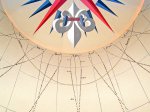 |
Englewood |
Colorado |
USA |
Gnomonic or Projection Dial |
Dial 555 |
| An internal cylindrical dial on the walls of the entrance tower to the Science Building of Kent Denver School. A glass-covered 1/8 inch aperture in the center of ceiling dome projects a spot light onto the inner vertical cylindrical wall of the vestibule. Aluminum strips mark the solar altitude and azimuth. Bronze strips mark the equinox and summer solstice. Bronze and nickel domed nails form the hour analemmas showing Mountain Standard Time with daylight savings time below. The dial design is by science teacher David Potter and architect Paul Hutton proportioned the "Sun Tower" so the summer solstice noon mark would be at the bottom of the cylindrical wall. Artwork on the ceiling includes a hand-painted winking "Sol" in a 24 point compass rose. |
| |
| |
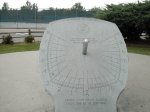 |
Englewood |
Colorado |
USA |
Equatorial Dial |
Dial 510 |
| The Archie Lynn Chase Sundial is an equatorial polar dial. Unlike other monumental polar dials (designed by Erickson Monument Co), the dial face is more of a rounded square than a circular disk. Hours, half hours, quarter hours and five minute lines mark the time from 4am to 8pm. The hour lines are rotated for the site latitude. A steel gnomon rod about 3 inches in diameter casts the shadow. Has a plaque describing the Equation of Time. |
| |
| |
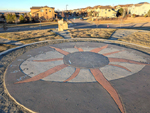 |
Erie |
Colorado |
USA |
Analemmatic |
Dial 1147 |
| Analemmatic human sundial, marked with both standard and daylight saving hours (5am-9pm MDT) arranged on an ellipse determined by the latitude.. The whole sundial is 10 ft (3m) in diameter, surrounded by a gravel moat. The zodiac walkway is encompassed in a circular center sun, with months marked in blue. Vertical sandstone stones at the edge mark the cardinal directions. |
| |
| |
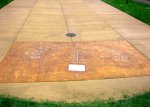 |
Glenwood Springs |
Colorado |
USA |
Analemmatic Dial |
Dial 576 |
| An 11x15 foot poured concrete human analemmatic dial with Standard and DST numerals, seasonal markers and an EOT plaque. The dial is located on the playground of an elementary school. |
| |
| |
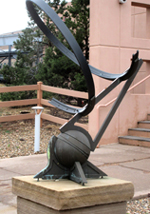 |
Golden |
Colorado |
USA |
Reflective Equatorial |
Dial 855 |
| This dial is one of Bill Gottesman's uniquely designed Renaissance dials of cast and structural bronze with a 27 inch diameter time telling helix whose axis is aligned to the celestial-north pole. Time is told by a focused beam of light from a long cylindrical unsilvered mirror situated on that N-S axis, reflecting sunlight into a slit of light onto the helix, telling time throughout the day. A sliding time scale within the helix is adjusted for longitude, date's equation of time correction and daylight saving time. Once this scale is adjusted for date, the dial shows civil (local clock) time with an accuracy of under one minute. The dial base is cast bronze that allows adjustment for latitude and is placed on a sandstone plinth. |
| |
| |
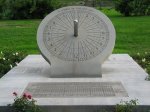 |
Littleton |
Colorado |
USA |
Equatorial Dial |
Dial 511 |
| The Littleton War sundial is an Erickson equatorial polar dial 6 feet in diameter made of light granite with a 3 inch steel rod as gnomon. Time is graduated by hour, half-hour, quarter hours and 5 minute marks over 24 hours. Noon is at the bottom, matching the 105 degree meridian. Designed to be read from the upper surface in Spring/Summer, from the under side in Fall/Winter. A plaque provides the Equation of Time to convert solar time to watch time. Dial is in a beautiful setting. |
| |
| |
 |
Pueblo |
Colorado |
USA |
Sun Alignment |
Dial 200 |
| Stonehenge type dial designed by Judy Guttormsen and built in 1984 . Stonehenge itself an amphitheater. If you stand on a brass marker in the center of the stage, on the solstices and equinoxes, you can observe the rising and setting of the sun aligned with metal posts viewed through slits in the wall. At the south edge of the site is a 6 foot horizontal dial laid out in the concrete floor. There are two rings of numbers, one for standard time, one for daylight time. Not corrected for longitude, but the location is very close to the center of the time zone. The gnomon is cement and is unusually thick (approximately 40 cm), making it very sturdy, presumably to prevent vandalism. The surface of the gnomon is very rough, having embedded pebbles, making it an uncomfortable place to sit or climb. The metal inscription plate on the gnomon has faded too badly to read. The site also has a North Star finder made of wrought iron and has a small bench for children to use. |
| |
| |
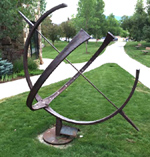 |
Steamboat Springs |
Colorado |
USA |
Equatorial Dial |
Dial 225 |
| This equatorial sundial is a memorial to Barbara Perry Cosel and sits in front of the"Bud" Werner library. A large 6 ft. thin iron equatorial, it is constructed of two 270 degree arcs that intersect at right angles. Time marks are simple detente marks on the equatorial arc. The gnomon is a traditional arrow. At the base of the dial is a plaque containing a graph of the Equation of Time to determine Mountain Standard Time. |
| |
| |
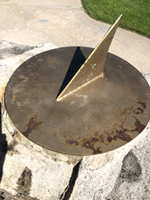 |
Sterling |
Colorado |
USA |
Horizontal Dial |
Dial 968 |
| This horizontal dial is 18 inches in diameter made of painted iron, and unfortunately parts of the dial face have rusted. The dial is marked hourly from 6am to 6pm to 6pm using Roman numerals at the dial circumference. Hour lines are made using a series of dots. The swept-wing design of gnomon has an angle of 42.5 deg, about 2 degrees higher than the latitude. The sundial sits on a sandstone boulder from Pawnee Pass, that was chosen by classmates for this memorial to honor Ken Malone who drown at North Sterling Reservoir. |
| |